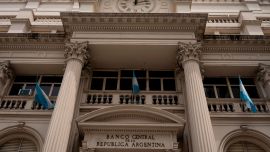Having burned through billions of dollars in reserves, Argentina’s government is getting creative as it looks to defend the peso ahead of crucial midterm elections later this month.
The Central Bank spent US$1.1 billion in the spot market last month when the currency breached its trading band and is now coming up to a limit imposed by Argentina's main exchange in the derivatives market. It raised its short position in dollar futures to around US$8 billion at the end of September, according to people familiar with the matter, just shy of the US$9-billion cap set by the A3 exchange. So the monetary authority has been looking for alternatives to contain devaluation bets.
Those bets have surged, despite the government’s efforts to stabilise the currency. Dollar futures now imply an annualised devaluation rate for the peso of about 60 percent, far above the Central Bank’s projected rate of below 30 percent for the coming 12 months, according to A3. The widening gap underscores how quickly confidence in the currency – and in President Javier Milei’s government – is eroding.
“This shows a deep fear of floating,” Juan Carlos Barboza, chief economist at Mariva Bank, said in a report to investors last week. “What we’re actually seeing is a soft peg – and the Treasury is losing much-needed reserves in the process.”
Among the alternative tools the Central Bank uses is a secondary market run by local stock exchange BYMA. Before it entered the platform was largely deserted. Volumes have been rising since the Central Bank’s first appearance on September 19, according to people with direct knowledge. Still, liquidity remains limited with open interest of US$141 million on Tuesday, making it difficult for investors to unwind positions. BYMA has set a cap on total short positions of US$6 billion, which can be expanded to US$12 billion. The Central Bank declined to comment.
It also started operating in a bilateral trading venue within A3, a sparsely used market where buyers and sellers can trade directly without a central counter party. The bank entered the market with less than US$10 million, one person familiar with the matter said. Banks using this venue face caps that limit positions at half their net worth or US$300 million, whichever is lower. Caps of short positions in this market total about US$6 billion, according to traders.
The quest to influence the peso went beyond the derivatives market, with the government also turning to the bond market. It recently carried out a US$4-billion debt swap, allowing the Central Bank to receive dollar-linked securities from the Treasury in exchange for peso bonds and notes. The measure, announced in the government’s Official Gazette, gives the Central Bank new tools to intervene in the currency market.
The Treasury sold at least US$1.5 billion over the past six sessions to keep the exchange rate below 1,430 pesos per dollar, according to trader estimates. Central Bank data show it had US$1.7 billion in dollar deposits as of October 2, suggesting the current figure is now below US$750 million. The Central Bank, meanwhile, is only allowed to intervene when the peso breaches either end of a floating band it agreed to with the International Monetary Fund.
The current level of holdings indicates that the government will likely need a fresh injection of cash from multilateral lenders and support from the US Treasury to meet debt payments due in January. “Despite Milei’s announcements of imminent US assistance and confirmation of an official visit to the White House on October 14, market expectations have continued to deteriorate,” economist Juan Manuel Truffa said in a recent report.
The government has also resorted to regulatory tweaks, offering short-lived tax incentives that encouraged dollar holders to sell part of their holdings to boost supply. In June and September, for example, it eased taxes on agricultural exports, prompting farmers to accelerate sales that would usually occur through the year. As a result, the peso appreciated, albeit briefly.
“The market is asking whether this exchange rate is the right one to move toward the growth model Argentina will need,” said Joaquín Bagues, managing director at local consulting firm Grit Capital Group.
by Ignacio Olivera Doll, Bloomberg
) The Central Bank of Argentina runs out of ammunition in futures and tests three alternatives to support the peso.


















Comments